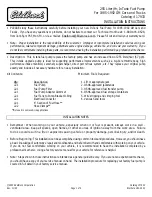
156
Driving and operation
Saving fuel, protecting the
environment
Trend-setting technology
Environmentally friendly and mainly
recyclable materials were used when your
vehicle was being developed and
manufactured. The production methods
used to make your vehicle are also
environmentally-compatible.
Recycling of production wastes keeps the
circulation of material closed. Reduction of
energy and water requirements also helps
to conserve natural resources.
A highly advanced design means that your
vehicle can be easily disassembled at the
end of its working life, and the individual
materials separated for subsequent re-use.
Materials such as asbestos and cadmium
are not used. The refrigerant in the air
conditioning system
3
is CFC-free.
New painting techniques employ water as
a solvent.
End-of-Life vehicle recovery
For detailed information on Vauxhall’s
on-going commitment to achieving an
environmentally-sustainable future,
including; design for recycling, take back of
End-of-Life Vehicle’s (ELVs) and the
recycling of ELVs, view
www.vauxhall.co.uk/recycling
for details.
Energy and environment-conscious
driving
z
High noise levels and exhaust emissions
are often a result of driving without due
attention to saving energy and
protecting the environment.
z
You should therefore drive with energy in
mind: "more miles – less fuel".
Reduce the noise level and exhaust
emissions by adopting an environment-
conscious driving style. This is extremely
worthwhile and improves the quality of
life.
Fuel consumption depends to a great
extent on your own personal driving
style. The following hints are intended to
help you consume fuel at a rate that is as
close as possible to the specified levels –
see page 272.
Check your vehicle’s fuel consumption
every time you refuel. This facilitates
early detection of any irregularities
causing increased fuel consumption.
Warming up
z
Full throttle and warming up at idle
speed increase wear, fuel consumption,
exhaust emission, the amount of
pollutant in the exhaust and the amount
of noise.
z
Drive off as soon as possible after
starting.
Uniform speed
z
Hectic driving significantly increases fuel
consumption, the exhaust emissions, the
proportion of pollutant in the exhaust
gas and the noise level.
z
Do not accelerate and brake
unnecessarily. Drive at uniform speed,
watching the road.
Avoid frequent starting-off and stopping
e.g. at traffic lights, in short distance
traffic and in queues of traffic by means
of clever planning. Select roads with
good traffic flow.
Idling
z
The engine also consumes fuel when
idling.
z
If you have to wait for more than one
minute, it is worthwhile switching off the
engine. Five minutes of idling
corresponds to approximately 0.6 miles
(1 km) of driving.
Ofrecido por www.electromanuales.com
















































